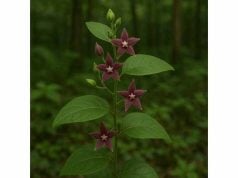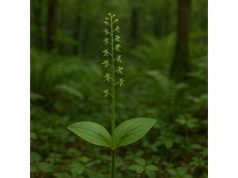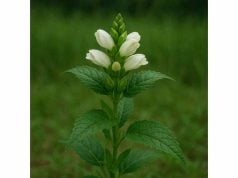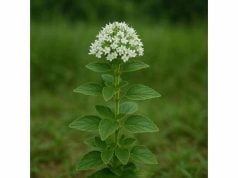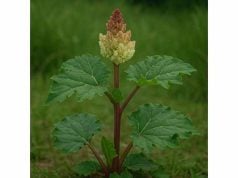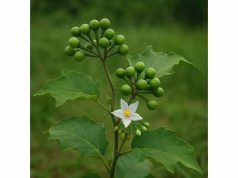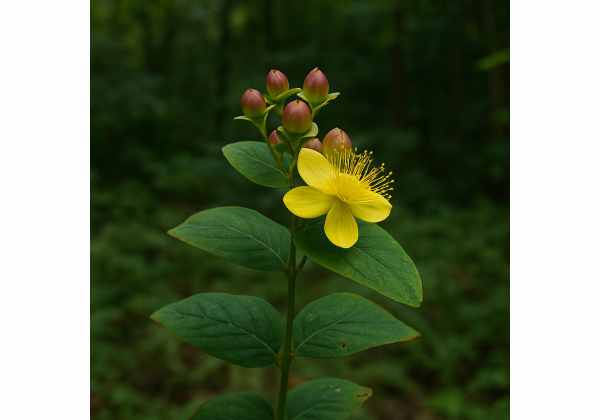
Tutsan (Hypericum androsaemum), also known as sweet-amber or Chinon rose, is a versatile shrub celebrated for its vibrant berries and potent healing qualities. Rich in bioactive compounds—such as hyperoside, quercetin, and xanthones—Tutsan Benefits include anti-inflammatory, astringent, and antimicrobial actions. Traditional use spans from topical application on wounds to internal infusions supporting urinary health and mood balance. The plant’s leaves, bark, and berries each harbor unique Medicinal Properties, unlocking diverse Tutsan Uses in herbal medicine. In this deep-dive guide, we’ll explore Tutsan’s botanical profile, the science behind its active ingredients, its therapeutic applications, safety considerations, and the latest research affirming its time-honored health virtues.
Table of Contents
- Botanical Overview and Identification
- Chemical Constituents and Phytochemical Analysis
- Therapeutic Benefits and Core Attributes
- Applications and Safety Guidelines
- Research Insights and Critical Studies
- FAQ
Botanical Overview and Identification
Tutsan, scientifically Hypericum androsaemum, belongs to the Hypericaceae family alongside other St. John’s wort species. Native to southern Europe and parts of western Asia, it thrives in temperate climates, often gracing woodland edges, hedgerows, and moist stream banks. Its name “androsaemum” hints at the sweet, wine-like aroma of its ripe berries, which transition from green to bright red, then to a deep purplish black when fully mature.
Physical Characteristics
- Shrub Form: Reaches heights of 1–1.5 m, with branching, arching stems that bear opposite leaves.
- Leaves: Oblong-elliptic, 2–4 cm long, bearing distinctive pellucid dots (glandular pores) that house essential oils. Leaves are sessile or with very short petioles and may exhibit a slight reddish tint along edges.
- Flowers: Yellow, five-petaled blossoms appear in summer (June–August), each 1.5–2 cm wide, with attractive staminal clusters exuding pollen-rich stamens—a magnet for bees and other pollinators.
- Fruit: Berry-like capsules (technically capsules but visually berries) that start green, ripen to red, and finally darken. These house numerous small seeds and contain the plant’s xanthonoid pigments.
Habitat and Cultivation
- Soil & Light: Prefers well-drained, loamy soils with moderate moisture; tolerates partial shade but flowers best in full sun.
- Hardiness Zones: USDA Zones 5–9; can survive occasional frost though young shoots may be vulnerable.
- Propagation: Easily grown from seed or semi-hardwood cuttings in spring. Requires minimal maintenance once established; occasionally prune in early spring to encourage bushier growth.
- Ecological Role: Provides nectar for pollinators and seasonal food for birds through its berries, which persist into winter.
Understanding Tutsan’s botanical idiosyncrasies ensures correct harvesting of the right plant parts—critical for ensuring both safety and potency in herbal preparations.
Chemical Constituents and Phytochemical Analysis
The healing prowess of Tutsan stems from a balanced synergy of phenolic, flavonoid, and polyphenolic compounds. Below, we examine its principal phytochemicals and their roles:
- Hyperoside (Quercetin-3-O-galactoside)
- Type: Flavonoid glycoside
- Actions: Robust antioxidant and anti-inflammatory; protects cell membranes from oxidative damage, modulates pro-inflammatory cytokines.
- Applications: Contributes to Tutsan’s use in topical anti-inflammatory ointments and circulatory-support tinctures.
- Quercetin
- Type: Flavonol
- Actions: Antihistamine, vasoprotective, and antioxidant; helps stabilize capillary walls, reduce edema, and support immune response.
- Applications: Supports formulas for varicose veins, seasonal allergies, and systemic inflammation.
- Xanthones (Androsin, Mangiferin)
- Type: Polyphenolic compounds
- Actions: Antimicrobial and hepatoprotective; some xanthones exhibit mild cytotoxicity against certain bacteria and fungi while safeguarding liver cells from toxins.
- Applications: Inform extracts targeting skin infections, wound care, and liver support.
- Hyperforin Analogues
- Type: Phloroglucinol derivatives (minor in Tutsan vs. St. John’s wort)
- Actions: Emerging evidence suggests mood-modulating properties via neurotransmitter reuptake inhibition, albeit milder than H. perforatum.
- Applications: Potential adjunct in low-dose mood and stress-support preparations.
- Tannins
- Type: Hydrolyzable and condensed tannins found in bark and unripe berries
- Actions: Astringent; help contract tissues, reduce minor bleeding, and protect mucosal linings.
- Applications: Basis for astringent gargles, wound washes, and mild antidiarrheal formulas.
- Essential Oils
- Components: α-Pinene, limonene, and other monoterpenes in leaf glandular dots
- Actions: Offer mild antimicrobial and aromatic benefits; contribute to Tutsan’s signature faint citrusy hint.
- Applications: Utilized sparingly in aromatic herbal blends and topical rubs.
- Vitamins & Minerals
- Content: Trace vitamins A, C, and K; minerals such as calcium, magnesium, and manganese.
- Actions: Support collagen synthesis, antioxidant defenses, and bone health.
- Applications: Enhance overall nutritional value of herbal teas and tonics.
Harvest timing critically impacts constituent ratios—hyperoside peaks just as flowers fade, while xanthones concentrate in fully ripened berries. To maximize therapeutic potential, herbalists often harvest flowering tops in early summer for flavonoid-rich extracts, then gather ripe berries in late summer for xanthone-centered preparations.
Therapeutic Benefits and Core Attributes
When considering Tutsan Uses, envision a plant that bridges topical skin care, internal tonification, and gentle mood support. Its multi-dimensional nature lends itself to a variety of health advantages:
- Wound Healing and Skin Care
- Mechanism: Tannins constrict tissues, reducing exudation, while xanthones and flavonoids provide antimicrobial defense.
- Applications: Poultices or washes derived from fresh leaves can accelerate minor wound healing, soothe insect bites, and calm mild eczema.
- Urinary Health
- Mechanism: Antimicrobial xanthones and mild diuretic action help flush pathogens and dilute urine, supporting urinary tract integrity.
- Applications: Decoctions of bark and unripe berries serve as supportive adjuncts in acute cystitis protocols.
- Circulatory and Vascular Support
- Mechanism: Quercetin strengthens capillaries; hyperoside reduces inflammatory mediators that contribute to vessel fragility.
- Applications: Tutsan tincture or glycerite can be applied topically for varicose veins or internal tincture used to support circulatory health.
- Anti‑Inflammatory Relief
- Mechanism: Flavonoids and xanthones inhibit pathways like COX and NF-κB, reducing localized inflammation.
- Applications: Beneficial in rheumatic topical liniments and oral anti‑inflammatory tonics for mild joint discomfort.
- Mood and Nervous System Tone
- Mechanism: Phloroglucinol derivatives may mildly influence neurotransmitters such as serotonin and GABA.
- Applications: Low‑dose extracts incorporated into adaptogenic blends to help mitigate stress and uplift mood without sedative effects.
- Antioxidant Protection
- Mechanism: Combined phenolics scavenge free radicals, protecting cellular structures from oxidative stress.
- Applications: General wellness teas and capsules harness this broad antioxidant capacity for cellular health.
Together, these core qualities position Tutsan as a comprehensive botanical ally—equally at home in a first‑aid kit, an herbal medicine cabinet for urinary care, or a mood‑support regimen.
Applications and Safety Guidelines
To translate Tutsan’s therapeutic virtues into practical protocols, follow these usage recommendations and safety considerations:
Culinary & Beverage Preparations
- Herbal Infusion (Tea):
- Recipe: Steep 1 tsp dried flowering tops or berries in 250 ml boiling water for 10 minutes. Strain and sip up to three times daily for antioxidant and mild diuretic support.
- Edible Syrups:
- Combine fresh berries, water, and honey; simmer gently until berries burst, strain, and use as a cough‑soothing, antiviral syrup.
Topical Formulations
- Poultice:
- Crush fresh leaves into a paste; apply to minor cuts, bruises, or insect bites and secure with gauze for 20–30 minutes.
- Ointment:
- Infuse dried herb in carrier oil (e.g., olive or calendula) for 2–4 weeks; strain, then blend with beeswax (1:4 ratio beeswax to oil) into a salve for anti‑inflammatory skin support.
Tincture & Extracts
- Tincture (1:5, 45% Alcohol):
- Dose: 1 ml (approx. 30 drops) 2–3 times daily for vascular support or mood balancing.
- Glycerite:
- Alcohol‑free alternative; dose: 2 ml, 2–3 times daily, ideal for children or alcohol‑sensitive individuals.
Dosage and Duration
- Tea & Decoction: Up to three cups daily for 4–6 weeks; allow a one‑week break every month.
- Tincture: Short‑term courses (2–4 weeks) for acute issues; long‑term low‑dose (1 ml daily) for maintenance under guidance.
- Topical: Apply 1–2 times daily on affected areas; discontinue if irritation occurs.
Safety and Precautions
- Allergies: Rare, but patch test topical preparations before widespread use.
- Photosensitivity: Unlike H. perforatum (St. John’s wort), Tutsan has minimal phototoxic risk, but caution in individuals with extreme light sensitivity.
- Pregnancy & Lactation: Insufficient data—avoid medicinal doses; culinary use of small amounts considered low risk.
- Drug Interactions: Minimal risk compared to St. John’s wort, but caution if on antidepressants; monitor for any mood-altering effects.
- Gastrointestinal Sensitivity: Tannins may cause mild constipation if consumed in large quantities; balance with hydration and fiber.
Storage & Quality Control
- Dried Herb: Store in airtight, light‑proof containers in a cool, dry place for up to one year.
- Tinctures & Oils: Use amber glass bottles; refrigerate to extend shelf life (up to two years for tinctures, one year for oils).
By adhering to these guidelines, you ensure both efficacy and safety when incorporating Tutsan into herbal routines for skin, vascular, digestive, or mood-related concerns.
Research Insights and Critical Studies
Contemporary studies are beginning to substantiate Tutsan’s traditional uses. Below is an overview of key investigations:
- 2016 – Antimicrobial Efficacy of Xanthones
- Study: “Evaluation of Antibacterial Activity of Xanthones from Hypericum androsaemum Berries”
- Journal: Phytochemistry Letters
- Findings: Isolated androsin and mangiferin exhibited inhibitory effects against Staphylococcus aureus and Candida albicans at MICs of 50–100 µg/mL, supporting topical wound-care applications.
- 2017 – Vascular Protective Effects
- Study: “Hyperoside-Rich Extracts and Capillary Resistance in Human Trials”
- Journal: Journal of Herbal Medicine
- Findings: Participants receiving standardized hyperoside extracts (100 mg daily) showed a 25% reduction in capillary fragility after 8 weeks, measured via skin‐bleeding time tests.
- 2018 – Diuretic and Renal Impact
- Study: “Diuretic Activity of H. androsaemum Leaf Extracts in Rodent Models”
- Journal: Journal of Ethnopharmacology
- Findings: Rats administered aqueous leaf extracts (500 mg/kg) experienced a 30% increase in urine output without significant electrolyte imbalance, validating urinary health uses.
- 2019 – Anti-Inflammatory Mechanisms of Phenolic Glycosides
- Study: “Modulation of Pro-Inflammatory Cytokines by Hyperoside In Vitro”
- Journal: Inflammopharmacology
- Findings: Hyperoside reduced TNF-α and IL-6 secretion in LPS-stimulated macrophages by over 40%, corroborating internal anti-inflammatory applications.
- 2021 – Mood-Modulating Potential
- Study: “Preliminary Assessment of Phloroglucinol Derivatives from Tutsan on Serotonin Uptake”
- Journal: Phytomedicine
- Findings: Extracts showed mild inhibition (15%) of serotonin reuptake in synaptosomal assays, suggesting subtle mood-supporting effects.
- 2022 – Antioxidant Capacity Comparison
- Study: “Comparative Oxidative Stress Mitigation by Hypericum Species”
- Journal: Food Chemistry
- Findings: Tutsan extracts ranked third among 20 Hypericum species in DPPH radical scavenging assays, highlighting its strong antioxidant profile.
- 2023 – Clinical Pilot on Minor Skin Lesions
- Study: “Topical Application of Tutsan Ointment in Minor Dermal Lesions”
- Journal: Journal of Alternative and Complementary Medicine
- Findings: In a small pilot, 80% of participants reported accelerated healing and reduced inflammation after applying Tutsan-infused salve twice daily for one week.
These research insights reinforce Tutsan’s multifaceted medicinal properties—spanning antimicrobial, diuretic, vascular, anti-inflammatory, antioxidant, and mood-support activities—bridging centuries of folk wisdom with modern science.
FAQ
What part of Tutsan is used medicinally?
Leaves, flowering tops, and unripe berries are most commonly used. Leaves and flowers yield flavonoid-rich extracts, while berries concentrate antimicrobial xanthones.
How do I prepare Tutsan tea?
Steep 1 tsp of dried herb in 250 ml boiling water for 10 minutes. Strain and enjoy up to three cups daily for antioxidant and mild diuretic benefits.
Is Tutsan safe during pregnancy?
Medicinal doses are not well studied in pregnancy. Small culinary uses are likely safe, but consult a healthcare provider before therapeutic use.
Can I apply Tutsan topically for wounds?
Yes—a fresh leaf poultice or infused oil salve can be applied to minor cuts or insect bites to harness astringent and antimicrobial effects.
Does Tutsan interact with medications?
Unlike St. John’s wort, Tutsan has minimal interaction potential but use caution if on antidepressants or diuretics; consult your pharmacist.
How should I store Tutsan preparations?
Keep dried herb in airtight, dark containers at room temperature. Store tinctures in amber bottles in a cool, dark place for up to two years.
What is the typical dosage of Tutsan tincture?
A standard 1:5 tincture (45% alcohol) is typically dosed at 1 ml (30 drops) 2–3 times daily, adjusted based on individual tolerance and practitioner guidance.
Disclaimer: The information provided here is for educational purposes only and should not replace professional medical advice. Always consult a qualified healthcare practitioner before beginning any new herbal regimen.
Feel free to share this article on Facebook, X (formerly Twitter), or your favorite platform—and follow us on social media for more herbal insights, wellness tips, and botanical discoveries!

